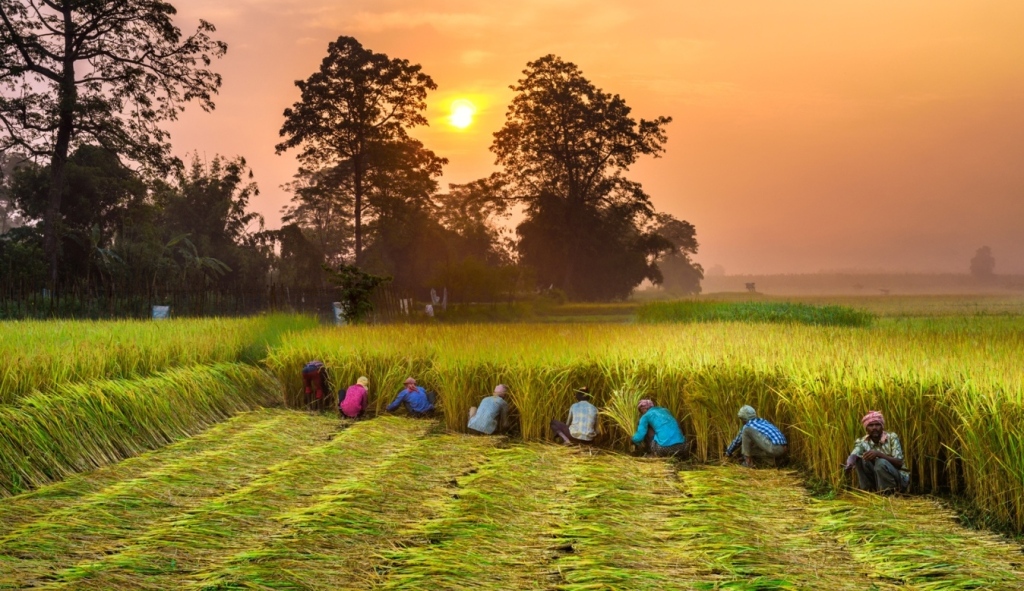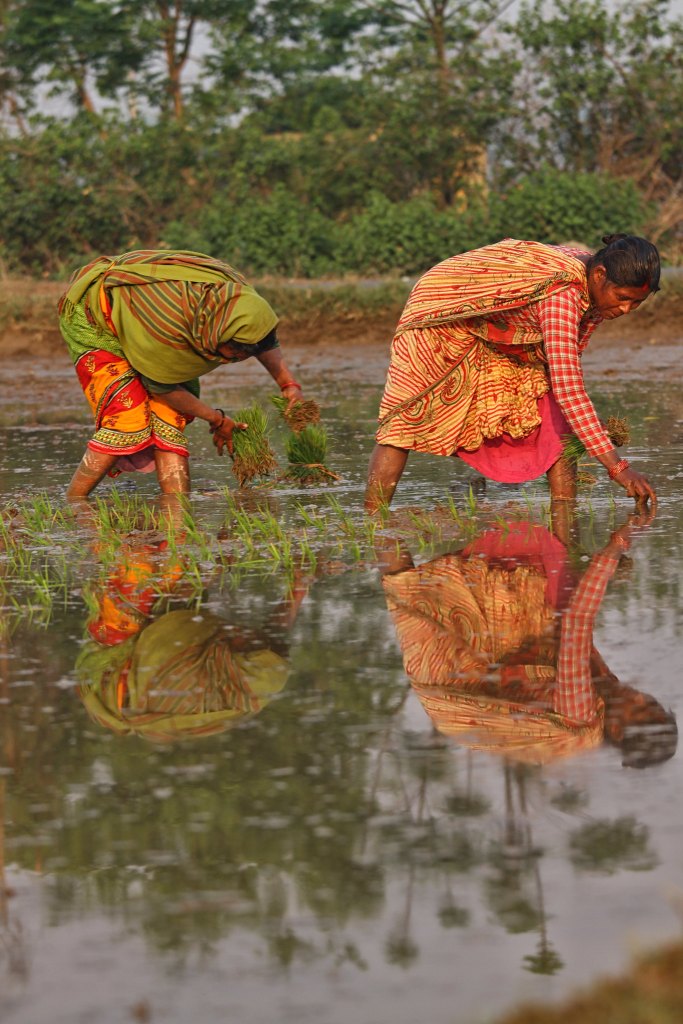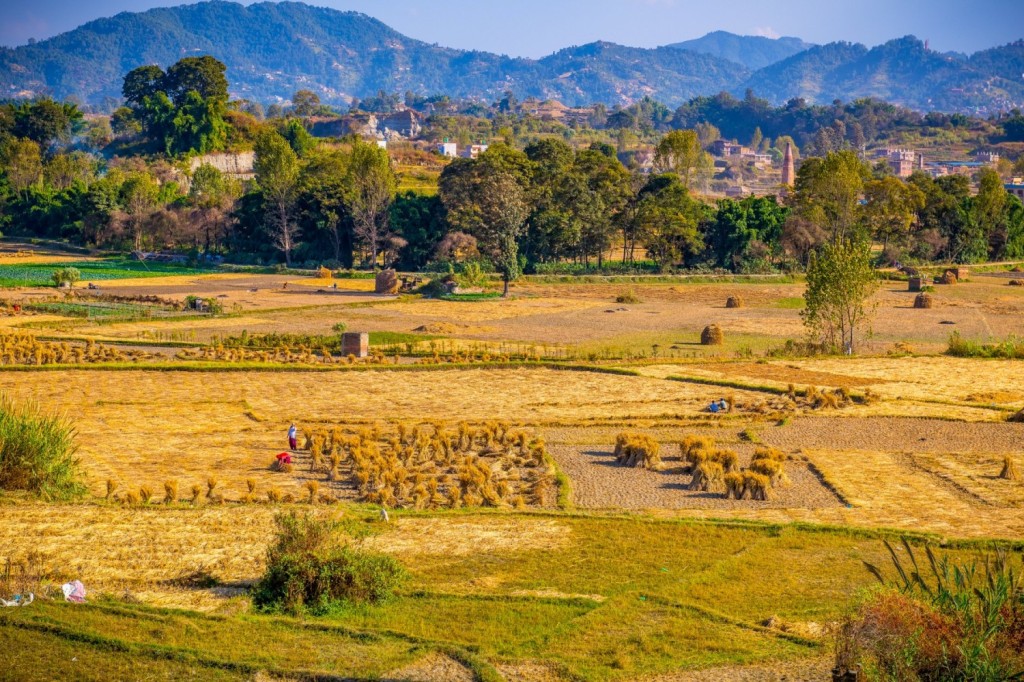Best time to go to Nepal
Nepal attracts visitors keen to explore its diverse scenery – from jungles to high mountain peaks, to discover its fascinating wildlife and delve into its rich cultural heritage.
Weather in Nepal
When is the monsoon in Nepal?
When is the best time to visit Nepal?
When is the best time to visit Kathmandu?
When to go trekking in Nepal
Festivals in Nepal
The country has much to offer all year round. Differences in the seasons determine where’s good to go at any given time of year – meaning the best time to go to Nepal goes hand-in-hand with the activities on your wishlist.

Weather in Nepal
Nepal is broadly temperate, with four main seasons centred around the summer monsoon from June to September. The build up to the monsoon is stiflingly hot with afternoon clouds and rain showers. The subsequent monsoon brings relief with a drop in temperatures and the heavy rains bring the countryside into bloom.
While winter is mostly clear and stable it can also be seriously cold in trekking areas. Spring sees warm weather, while the months of autumn are clear, dry and fresh after the recent rains.
Each season has its charms and each offers something different to travellers exploring this wonderful Himalayan country.
When is the monsoon in Nepal?
Nepalis welcome the monsoon, the timing of which may vary by a few weeks every year, but typically begins in mid-June and peters out in the last weeks of September.
During these months, expect to see heavy rains every day, especially in July and August. During June and September, rain is considerably lighter. The good news is that monsoon rains usually only last for a couple of hours and their timing is quite predictable. So it’s still possible to enjoy a great trip to Nepal during the monsoon – all you need to do is choose your destination and itinerary carefully, especially if trekking is top of the list.
The monsoon doesn’t affect all of Nepal equally. Areas in the Himalayan rain shadow, such as Dolpo and Humla in western Nepal and the Mustang region north of Annapurna, are spared the drenching other areas receive. The area of Pokhara is the wettest part of Nepal during monsoon.
The main thing to remember about the monsoon season is that you need to be flexible with your travel plans. In some areas, flights may be delayed or cancelled due to heavy rains. Landslides can happen, causing road closures. Always check with your hotel or guest house before heading on a road trip during monsoon season. They should be able to find the most up-to-date information about road conditions. Bring appropriate waterproof clothing and keep your electronics in waterproof bags if you’re out and about.
And bear in mind, when the rain stops it will still be hot and sunny, so you can still get out and discover the country during the monsoon season.
When is the best time to visit Nepal?
The best time to visit Nepal depends on what you plan to do while in the country. Fall/autumn and spring are the most popular times to visit for hikers, climbers and mountaineers. At this time, clear skies and pleasant temperatures create the ideal conditions for adventures in the mountains.
Low season (which coincides with the monsoon season) can be an option if you’re on a budget. Firstly, you’re likely to find discounts on accommodation and tours – plus, you won’t have to deal with crowds. Secondly, if you don’t plan on hitting the Himalayas, monsoon season can be a great time to visit.
Spring is a good time to visit Nepal’s valleys and forests. March marks the start of the blooming season in many parts of the country and large areas are covered in bright pink rhododendrons – Nepal’s national flower. This is also a great time to explore centres of Buddhist culture and architecture, such as Tengboche monastery.
You can have a fabulous travel experience in Nepal during the winter. Low humidity and minimal chances of rain make this season great for travel photography and low-altitude hikes.
When to visit Nepal in winter
Winter in Nepal is cold, but cold temperatures are balanced by brilliant sunshine and clear blue skies. It can be a wonderful time for the more experienced trekker to tackle the mountains. Winter weather in Nepal is also perfect for taking photos that capture the country’s stunning natural beauty.
Visiting Nepal in December – February

In terms of the weather, winter is the perfect time to visit Chitwan National Park, a great destination for jungle walks and safari expeditions. The park is home to Bengal tigers, elephants, rhinos, and more than 500 bird species. For the best chances of spotting wildlife, plan your trip around January or February. It’s worth noting, however, that this is one of Nepal’s most popular destinations, so unless you opt for the rainy season for a trip to Chitwan, you’ll be rhino spotting with a whole lot of other visitors. Bardia National Park, northwest of Nepalgunj, is a quieter alternative and offers the best chance to see tigers in Nepal.
The cold season is also a good time to spend a few days exploring Bandipur. This charming town will catch your eye with its traditional wooden architecture, busy markets, and scenic trails. The town is a five-hour drive from Kathmandu, which makes it a convenient getaway if you get tired of the capital’s hectic pace.
Speaking of Kathmandu, winter is a great time to layer up and explore the old city. Low temperatures are the perfect excuse to sit at a café in Thamel and enjoy a glass of Nepali tea, which comes in many varieties, or a cup of Nepal’s own-grown coffee.
The winter months are generally dry and settled, so it can be a good time for trekking – although it is inevitably colder. There can be snow at 2500m – sometimes lower, while conditions can mean passes over 4000m are uncrossable. You’ll also need appropriate gear for cold temperatures and heavy snowfall if trekking at high altitudes. Challenging conditions aside, if you’re an experienced trekker this can be a wonderful time to be on the mountains, with far fewer trekkers venturing out. At lower altitudes it can feel more like spring already.
When to visit Nepal in spring
Spring is one of the most popular seasons to visit Nepal. Snowfall begins to die down around March and makes it easier to move along hiking trails, so this is a fairly busy time in Nepal’s high-altitude destinations, although not as busy as in autumn/fall. But hiking and climbing are not the only things to do in the spring. In general, this is a great time to discover nature in Nepal.
Visiting Nepal in March – May
April is peak time for travellers heading to Everest base camp and the Annapurna circuit. These months are also a popular time to do short treks in the Nepalese countryside, for example at Ghorepani and Poon Hill or Mardi Himal.
But the options don’t end there: you can also explore lesser-visited destinations, such as the tea plantations in Ilam, in eastern Nepal. There’s also Panch Pokhari, a remote high-altitude wetland area home to five glacial lakes. Mountain scenery could also be your stunning backdrop at one of Nepal’s yoga retreats.
By May it is getting hotter and hazier and the weather is somewhat unsettled, with afternoon storms quite common. Go high if you’re trekking and expect rain, especially in the known wetter regions, such as Annapurna and the far eastern parts of the country.
When to visit Nepal in summer
Summer brings the monsoon rains to most of Nepal. At this time of the year, Nepal’s climate is hot and humid, so the rains bring a refreshing break from the heat. But although Nepal is generally wet, the mornings are often clear and the countryside is bursting with colour – vivid green forests and rice terraces and bright wildflowers.
What’s more, summer is a pleasant time to go to Nepal if you want to avoid big crowds and peak season prices.
Visiting Nepal in June – August
Early summer is a fantastic time of year to discover Kathmandu’s historical heritage, without the crowds. And if you get caught in the monsoon rain (mid-June to early Sept), you can always wait for it to pass at one of the many cafés and tea houses.
If you’re into landscape or wildlife photography, early June is the time to see the spectacular landscapes at Shey Poksundo (She-Phoksundo) National Park. This is the country’s biggest national park, and as such, it’s home to hundreds of animal and plant species. You may even be able to spot endangered species here, such as Himalayan black bears, snow leopards and blue sheep.
Most people who visit Nepal for its superb trekking opportunities avoid the monsoon. Downpours can render trekking paths too slippery and muddy – plus, there are leeches to contend with! Mountain views may be obscured and general travelling around can prove problematic.
That said, you don’t need to rule out trekking altogether. Avoid wet areas, such as Annapurna and the far east of Nepal and stick to parts where the monsoon is weaker instead. The far west and areas in the Himalayan rain shadow are relatively sheltered. These include Dolpo, Humla and the mystical Mustang region north of Annapurna.
Mustang, home to Kali Gandaki Gorge, which at 8,270 feet (2,520 metres) is the deepest gorge in the world. Other must-sees in the area include villages such as Marpha (also known as the Apple Capital of Nepal) and Kagbeni.
Just remember, if you are travelling to Nepal for trekking expeditions, allow for sudden changes to your itinerary. The rain can affect transport, with delays and cancellations possible. Check road conditions before you venture out and bring waterproof clothing.
It’s as well to bear in mind, when the rain stops it will still be hot and sunny, so you can still get out and discover the country during the monsoon season.
When to visit Nepal in fall/autumn
Fall or autumn is one of the best seasons to travel to Nepal. From October it’s generally dry and skies are clear, which is why climbers and hikers love this season.
Daytime temperatures during the day at high altitudes are pleasantly cool for walking, whereas it’s hotter lower down. At night it’s getting colder high up but it’s unlikely to be too severe.
You’ll also have the chance to enjoy some of Nepal’s biggest festivals, such as Dashain (Desain, or Dashera) and Tihar (Tihaar), important Hindu festivals.
Visiting Nepal in September – November
The period after the monsoon, around September to early October can be unpredictable. If the rains have finished you’ll be blessed with mild temperatures and clear skies, which is why fall or autumn can be one of the best seasons to travel to Nepal. Trekking trails are also quiet – a joy for hikers and mountaineers. If you’re unlucky though, the monsoon may not have quite tailed off yet. In that case it could be hot and sticky and you may get caught in heavy showers – or even snow. Also those stunning mountain views could be shrouded in clouds.
Mid-October to mid-November is the best time for serious climbing and mountaineering in Nepal. But this also means that from September it’s the busiest time in the Himalayas. If you’d rather avoid the crowds, consider less popular destinations and activities:
Nagarkot is one of the most photogenic places in Nepal. Temperatures may be chilly in the early morning and late evening, but visibility is great and you’ll enjoy panoramic mountain views.
A multi-day rafting or kayaking trip along Sun Kosi (Sun Koshi) River or Ghaghara River. These trips are a great way of seeing the country and staying active at the same time.
The Gokyo Lakes trek, where you’ll enjoy dramatic views of some of the world’s highest mountains.
Cycling in the Kathmandu Valley and southern Nepal. The Terai lowlands are a fantastic destination for a two-wheel holiday. And they’re suitable for cycling beginners too.
When is the best time to visit Kathmandu?
Generally speaking, September to November is the best time to visit the city. At this time of the year, you’ll find dry weather, clear skies, and plenty of cultural events. But in fact, there’s no wrong time to visit the city.

Kathmandu weather is relatively mild compared to other parts of the country. The average annual temperature in Nepal’s capital city is a pleasant 18°C. January is the coldest month in Kathmandu (average 9°C). The hottest month is June with average temperatures of 23°C, and the wettest is July with more than 15 days of rain in the month. If you want to avoid rainy weather, November is your best bet.
The Kathmandu Valley is not as affected by monsoon rains as other parts of the country. Some flooding may happen here and there, but it shouldn’t affect your sightseeing plans. Remember that monsoon rains only last a few hours. Plan your activities around this, and you should have no problem visiting Kathmandu during the rainy season.
When to go trekking in Nepal
If you’re interested in high-altitude treks, it’s best to avoid the coldest winter months unless you’re experienced with cold weather conditions and have the necessary gear. Between December and February, heavy snowfall can make some trails and roads dangerous or impossible to cross.
On the other hand, spring – and the period before winter, bring dry and warm weather. These seasons are the best for high-altitude expeditions such as those to Annapurna, Everest, or Langtang.
Trekking in Nepal doesn’t always have to involve great heights. There are many short and lower-altitude hikes you can do around the Kathmandu Valley. A trek on the forested mountain of Phulchowki (Phulchoki) will take you from subtropical vegetation through Nepal chestnut, evergreen oaks and, of course, rhododendron. The unspoiled forest is one of the best places in Nepal for butterfly-spotting and birdwatching.
Or you can choose the Champadevi trek and go on a discovery journey of Tibetan monasteries.
These treks can be done all year round, except for the rainy season. For safety always go with a group when going on walks in the Phulchowki forest, as there have been robberies in recent years. And stick to the trails – anti-personnel mines were laid during the conflict in this region and you can’t be 100% sure that they’ve all been removed.
Read more on trekking: where to go and when, accommodation, remote and restricted areas, organised treks and trekking independently, equipment, safety – and more.
Festivals in Nepal
The weather is not the only factor when thinking about when to go to Nepal. This Himalayan nation has a rich history, which can be discovered through its festivals. Nepal’s festival calendar fills every month of the year with colourful celebrations that offer interesting insights into the local culture. Here are some things you should know about festivals in Nepal:
The exact date varies from year to year. This is because it is calculated based on the lunar calendar.
Many Nepali festivals last several days. For example, Holi can last for a whole week, and Dashain runs for 15 days.
Although there are festivals all year round, September to November is considered “festival season”. If you’re interested in the local culture, this is the best time to visit Nepal.
Nepal’s five biggest festivals are Dashain (Sept/October), Holi (early spring), Nepalese New Year (which usually falls in April), Tihar (November), and Teej (Tij), a women-only celebration usually held in late summer.
The majority of festivals have spiritual or religious origins. As a visitor, you’re welcome to observe – just remember to be respectful.
Nepal is a multicultural nation. Some festivals are celebrated all over the country, but others are only observed by certain ethnic groups. Also, the rituals and celebrations can vary from community to community.
Festivals are a great opportunity to try traditional Nepalese food. Sweet treats are everywhere during the Tihar festival. If you’re around for Holi, you’ll want to try dahi balla, or lentil fritters topped with yogurt and chutney. They’re addictive! Some of these delicacies are only prepared once a year, so don’t miss your chance.

